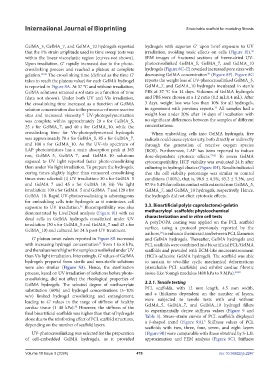Page 487 - IJB-10-3
P. 487
International Journal of Bioprinting Stretchable scaffold for modeling fibrosis
GelMA_5, GelMA_7, and GelMA_10 hydrogels reported hydrogels with superior Gʹ upon brief exposure to UV
that the 1% strain amplitude used in time sweep tests was irradiation, avoiding toxic effects on cells (Figure 8I). 36
within the linear viscoelastic region (curves not shown). SEM images of fractured sections of freeze-dried UV-
Upon irradiation, Gʹ rapidly increased due to the photo- photocrosslinked GelMA_5, GelMA_7, and GelMA_10
crosslinking process and reached a plateau at complete hydrogels (Figure 8C–E) revealed increased pore sizes with
38
gelation. 28,29 The crosslinking time (defined as the time Gʹ decreasing GelMA concentration (Figure 8F). Figure 8G
takes to reach the plateau value) for each GelMA hydrogel reports the weight loss of UV-photocrosslinked GelMA_5,
is reported in Figure 8A. At 37 °C and without irradiation, GelMA_7, and GelMA_10 hydrogels incubated in sterile
GelMA solutions retained a sol state as a function of time PBS at 37 °C for 14 days. Volumes of GelMA hydrogels
(data not shown). Under both UV and Vis irradiation, and PBS were chosen at a 1:2 ratio (0.2 mL:0.4 mL). After
the crosslinking time increased as a function of GelMA 3 days, weight loss was less than 10% for all hydrogels,
39
solution concentration due to the presence of more reactive in agreement with previous reports. All samples had a
sites and increased viscosity. UV-photopolymerization weight loss under 20% after 14 days of incubation with
35
was complete within approximately 20 s for GelMA_5, no significant differences between the samples of different
25 s for GelMA_7, and 40 s for GelMA_10, while the concentrations.
crosslinking time for Vis-photopolymerized hydrogels When embedding cells into GelMA hydrogels, free
was approximately 70 s for GelMA_5, 85 s for GelMA_7, radicals could cause cytotoxicity, both directly or indirectly
and 100 s for GelMA_10. As the UV–vis spectrum of through the generation of reactive oxygen species
LAP photoinitiators has a main absorption peak at 365 (ROS). Furthermore, LAP has been reported to induce
nm, GelMA_5, GelMA_7, and GelMA_10 solutions dose-dependent cytotoxic effects. 37,41 To assess GelMA
exposed to UV light reported faster photo-crosslinking cytocompatibility, HCF viability was evaluated 24 h after
than under Vis light irradiation. To prepare the hydrogels, culturing in hydrogel eluates (Figure 8H). Results indicated
curing times slightly higher than measured crosslinking that the cell viability percentage was similar to control
times were selected: (i) UV irradiation: 30 s for GelMA_5 conditions (100%), that is, 98.9 ± 6.5%, 95.2 ± 5.3%, and
and GelMA_7 and 45 s for GelMA_10; (ii) Vis light 97.9 ± 5.4% for cells in contact with extracts from GelMA_5,
irradiation: 100 s for GelMA_5 and GelMA_7 and 120 s for GelMA_7, and GelMA_10 hydrogels, respectively. Hence,
GelMA_10. Rapid UV-photocrosslinking is advantageous the hydrogels did not elicit cytotoxic effects.
for embedding cells into hydrogels as it minimizes cell
exposure to UV irradiation. Biocompatibility was also 3.3. Bioartificial poly(ε-caprolactone)-gelatin
36
demonstrated by Live/Dead analysis (Figure 8I) with no methacryloyl scaffolds: physicochemical
dead cells in GelMA hydrogels crosslinked under UV characterization and in vitro cell tests
irradiation (30 s for GelMA_5 and GelMA_7 and 45 s for A polyDOPA coating was applied on the PCL scaffold
GelMA_10) and cultured for 24 h post-UV treatment. surface, using a protocol previously reported by the
24
authors, to enhance the interaction between PCL filaments
Gʹ plateau onset values reported in Figure 8B increased and GelMA hydrogels. Thereafter, GelMA hydrogels and
with increasing hydrogel concentration from 1 to 8 kPa, PCL scaffolds were combined into bioartificial PCL/GelMA
37
and the values were higher for samples crosslinked under UV scaffolds and provided with ECM-like microenvironment
than Vis light irradiation. Interestingly, Gʹ values of GelMA (HCFs-adhesive GelMA hydrogel). The scaffold was able
hydrogels prepared from sterile and non-sterile solutions to sustain in vivo-like cyclic mechanical deformations
were also similar (Figure S3). Hence, the sterilization (stretchable PCL scaffolds) and exhibit cardiac fibrotic
process, based on UV irradiation of solutions before photo- tissue-like Young’s modulus (400 kPa to 9 MPa). 22,20
crosslinking, did not affect the rheological properties of
GelMA hydrogels. The selected degree of methacrylate 3.3.1. Tensile testing
substitution (60%) and hydrogel concentrations (5–10% PCL scaffolds, with 12 mm length, 4.5 mm width,
w/v) limited hydrogel crosslinking and entanglement, and a thickness dependent on the number of layers,
were subjected to tensile tests with and without
leading to Gʹ values in the range of stiffness of healthy
cardiac tissue (1–40 kPa). However, the stiffness of the GelMA_5, GelMA_7, and GelMA_10 hydrogel fillers
38
final bioartificial scaffolds was higher than that of hydrogels to experimentally derive stiffness values (Figure 9 and
alone due to the reinforcing effect of PCL scaffold structures, Table 3). Stress–strain curves of PCL scaffolds displayed
6
depending on the number of scaffold layers. a J-shaped trend (Figure 9A). Stiffness values of PCL
scaffolds with two, three, four, seven, and eight layers
UV-photocrosslinking was selected for the preparation (Figure 9B) were comparable with those obtained by S-L.B.
of cell-embedded GelMA hydrogels, as it provided approximation and FEM analysis (Figure 9C). Stiffness
Volume 10 Issue 3 (2024) 479 doi: 10.36922/ijb.2247

